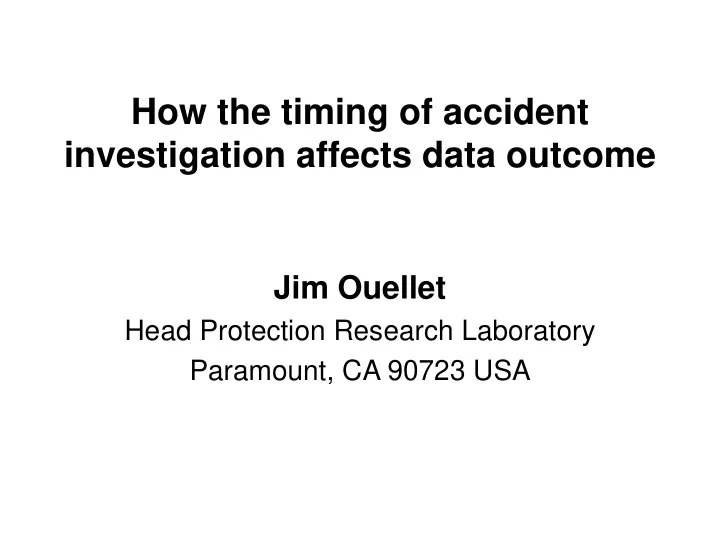

How the timing of accident investigation affects data outcome Jim Ouellet Head Protection Research Laboratory Paramount, CA 90723 USA
How do you find the crashes in time to investigate them? 1. Cooperative agreements with Police, Ambulance, Hospitals and Coroner 2. Immediate investigation is crucial because evidence degrades or disappears quickly once the accident scene clears.
Bare minimum elements to complete an investigation 1. Motorcycle examination 2. Rider interview 3. Helmet use / nonuse 4. Injury information
Additional elements 1. Helmet examination 2. Other vehicle inspection 3. Other vehicle driver interview 4. Medical imaging / records
Hurt Study “hot” and “warm” investigations • Contract required two-thirds of crashes to be investigated immediately after the crash (“hot” investigations). • The other one-third could be investigated up to 24 hours after the crash (“warm” investigations). • This avoided the high cost of around- the-clock staffing.
USC data, distribution of accident hour in hot and warm crashes & 3600 TARs 14 12 Hot (n=617) Warm (n=283) 10 Police reports (N=3600) Percent 8 6 4 2 0 6 7 8 9 10 11 12 13 14 15 16 17 18 19 20 21 22 23 0 1 2 3 4 5 Accident hour, 24 hour clock
Problems with “warm” investigations • Vehicles and people are difficult or impossible to locate, especially in minor injury crashes. • Refusal to cooperate far more likely. • Damaged parts & helmets may be tossed out. • Therefore, “warm” cases have far more “unknown” responses. • Follow-up investigations require far more man-hours to complete; many cases are lost.
Thailand investigations were all “hot” • Round-the-clock staffing was available. • It was nearly impossible to do “warm” investigations because people and vehicles disappeared. • There were so many crashes, that there was no need to take the great increase in time that follow-up investigations require.
Distribution of rider medical treatment in Hurt study hot and warm crashes 13.4 Warm (n=283) Fatal 2.6 Hot (n=613) 27.6 Hospital > 24 hrs 22.9 ER or < 24 hours 39.6 39.7 hospital 19.4 First aid at scene 34.2 0 5 10 15 20 25 30 35 40 45 Percent
Rider medical treatment in hot and warm crashes, Hurt study (all) & Thailand 5.7 Thailand (N=1081) Fatal 6.0 Los Angeles (N=896) 20.7 Hospital > 24 hrs 24.3 47.8 ER or < 24 hours hospital 39.7 25.7 First aid at scene 29.6 0 5 10 15 20 25 30 35 40 45 50 Percent
Rider medical treatment in European MAIDS & Thailand 5.7 Thailand (N = 1081) Fatal 10.9 MAIDS (N = 914) Hospital, unk days 15.4 9.3 Hospital > 8 days 13.1 58.8 Hospital <9 days 56.8 25.7 First aid at scene 2.7 0 5 10 15 20 25 30 35 40 45 50 55 60 Percent
Conclusions 1. In the Hurt Study, the availability of evidence in “warm” investigations appeared to introduce a bias toward fewer minor injury crashes and more of the serious / fatal crashes. 2. “Hot” investigations seem to lack this bias. 3. Therefore, “hot” investigations may be more representative of the general accident population.
Issues • What is most important to find? • Is it useful to have 75% of a crash sample be relatively minor crashes? • Would more be gained by studying more serious crashes?
Recommend
More recommend